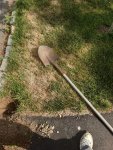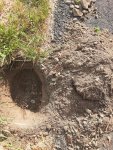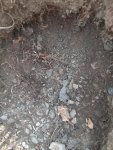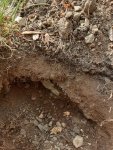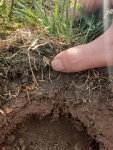What I see is compaction and shallow watering.
╪╪ We've tried watering frequently(every day, sometimes more than once) and for 5-10 min, as well as infrequently (every 3-5 days) but deeply, 30-40 min, and neither seemed to make a difference versus the other, but I'm sure helped more than not watering at all.. I also spritz it for 2-3 min around mid-day during the real hot 85º+ days in summer, just to wick the heat away via evaporation, like golf courses do, regardless of the watering method I'm using. I've read that this helps to take the stress away from the grass in hot weather.
The other problem is the pH of the rubble compared top the pH of the soil & the mulch on top of the soil. IS this compatible with your grass? Or is the rubble left overs from construction & contains toxic chemicals like concrete
binders?
╪╪ I don't think they contain toxic anything, but I'd have to get it thoroughly tested for that. It's been exposed to the elements for 5+ years, so I'd think the rain/snow/sleet/hail would wash any of that down and out of the area by now right?
╪╪ I don't see much evidence of concrete work on the area. It's really just asphalt and then stone dust/hardpack beneath it. Even the curbstone is asphalt. It does heat up, but nothing I can do about that.
╪╪ Not sure what the PH of the 'quality' soil on top -or- the PH of the 'construction' soil beneath; I simply put pelletized lime or hardwood ash down every spring to bring down the acidity that was thrown onto it by the salt trucks in the winter, + Massachusetts soil tends to be acidic anyway. I've used many different types of seed over past 5 years; different brands of KBG, TTTF, and Perennial Rye. All seem to be effected equally. Never used something elite like Midnight due to these other "big box" purchased grasses getting damaged, didn't want to burn money on expensive elite dwarf KBG cultivars when it might just get eviscerated and be a waste of money.
╪╪ And yes, I saw those little roots going down into the rubble, so I don't think the rubble is toxic to it in any way, but the grass certainly seems to prefer to hang around the upper 2" or so of rich in organic material soil instead of pushing roots down deep into the 'rubble'. If I had known the quality of this construction soil beneath this area, I would have dug it out 10" down and replaced with top soil.
╪╪Even still, and correct me if I'm wrong, it doesn't seem like an impossibility to, over time, remediate this soil by continuing to add organic matter to it, and letting the bugs/microbes do the work on the soil beneath, essentially creating 6" or so of my own top soil?
I would suggest hiring a deep aerotaters , preffably one that pulls little plugs out of the ground followed by a deep watering to get some water down into that sub soil
IF this makes the dead areas substantially worse by the end of the season then you know that sub soil is toxic to your grass & that area probably will need a deep exacvation to remove that rubble.
╪╪ Yes, this is a good idea. I used to borrow a friends rental aerator, but he did not rent one this year, and in the past I never aerated this particular part of the property. Unlike my last location, which was heavy clay, this area is the opposite - sandy underneath the 2" of good soil - so I didn't feel I needed to aerate, thinking the oxygen/water would simply flow right down easily. But, what you say makes sense in terms of using the plug aerator and water to detect toxicity. Also, aerating certainly can't hurt, especially if I brought in compost post-aeration and spring raked it into all the plug holes, helping to improve the soil quality at the same time. Might be a good idea to do that during a second aeration, though, if I'm going to use the first aeration to test for toxicity from the construction "rubble" sub-soil. Thank you for the response. Hopefully I interpreted everything you said correctly.

